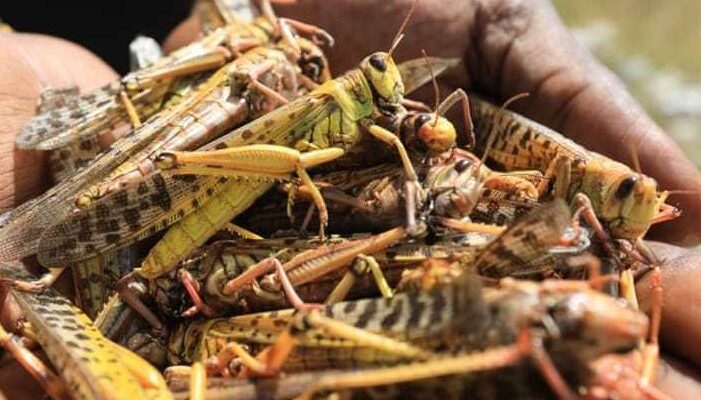For the unsuspecting farmer, the Desert Locusts are the formidable enemy. These wretched pests have a voracious appetite, multiply rapidly and travel up to 150 kilometers a day with the capacity to devour vast swathes of crops and pasture-land on the way.
In the past year, waves of the insidious insect swept across East Africa, Yemen and southwest Asia in massive swarms that contained up to 80 million in a single square kilometre. The threat to agriculture and food security has been immense and the challenge to bring them under control, urgent.
In response, Food and Agriculture Organization of the United Nations (FAO), with partners and donors, developed an array of high-tech tools that revolutionised locust detection, surveillance and treatment, helping affected countries to effectively control them.
Using climate data and weather forecasting, FAO has been at the forefront in the fight against locusts for decades. Its ground-breaking eLocust3 tablet, which field teams use to collect crucial data around the world and feed it to FAO’s Desert Locust Information Service, meant that FAO and national authorities could map locust movements and stay one step ahead of the game. “It’s really the Rolls Royce of our data collection tools,” says Keith Cressman, FAO’s senior locust forecaster.
But, despite the tablets being used in 20 countries, the latest locust emergency meant that demand skyrocketed and time was too short to train the farmers and pastoralists. FAO was fighting a battle on several fronts and needed a heavier hand to tackle the onslaught.
“We are constantly looking for cutting edge technologies to harness and adapt them into innovative tools that can be used to improve our forecasting and early warning,” says Cressman.
Remote communication tools
By January 2020, Desert Locust swarms the size of Paris or New York were sweeping across the Horn of Africa, a region already impacted by poverty and food insecurity. With the pests’ ability to multiply 20 times with each generation, every day that passed made the fight more challenging.
Up against the clock, Cressman turned to researchers at Pennsylvania State University‘s PlantVillage, which provides technological solutions to farmers and had previously created an app to help FAO track another dangerous agricultural pest, the Fall Armyworm.
“Instead of reinventing the wheel, why not use their expertise with the existing technology. Let’s adapt that app and use it for locusts,” comments Cressman.
In less than a month, Cressman and the developers created a simple smartphone app to allow anyone, even with little training, to collect locust data in the field. But, not every farmer has a cell phone and plenty of areas in East Africa are totally isolated from any network. So FAO also partnered with global GPS supplier Garmin, to modify a satellite data communicator that would overcome connectivity obstacles in areas that have none.
Though FAO now receives up to 2,500 records of data a day, nearly 25 percent of the data is unusable or incorrect and FAO again turned to PlantVIllage to harness artificial intelligence to rapidly identify and remove the unwanted data.
FAO’s Desert Locusts team then shares this data with control teams on the ground and in the air so they can quickly identify the location of the swarms, and then target and kill them.
Detection from the air
A telephone call from one of Kenya’s wildlife conservancies has also led to another technological breakthrough. On the suggestion of one of the rangers, FAO took a digital system, called Earth Ranger, used to monitor the movement of animals, and adapted it for locust monitoring.
Cressman worked with the developers of Earth Ranger, a philanthropic foundation called Vulcan, to fine tune it specifically for aerial surveillance and locust control. At the height of the locust response, FAO partnered with 51 Degrees who used this tool to co-ordinate 28 aircraft in the Horn of Africa for surveillance and control operations, giving pilots the precise information they needed to target locusts on the move. The technology was so effective in locust operations in Kenya that FAO soon expanded its application to Ethiopia and Somalia.
“Before we were just operating in the dark. With Earth Ranger you can see exactly the path the aircraft has taken and where it has sprayed. It has led to a more effective use of the aircraft, and more efficient control operations. I’m sure that is a major factor which contributed to the decline in the upsurge which we are seeing now.”
FAO is also collaborating with researchers from the US National Oceanic and Atmospheric Administration, the UK Meteorological Office and Cambridge University to develop new ways to improve swarm surveillance, forecasting and control strategies.
A space age boost to surveillance
Satellites may be the biggest game changer in the fight against Desert Locusts. Since rainfall is a critical component for locust breeding, FAO is using two satellites to identify rainfall and vegetation that might be attract locusts for breeding. ‘’It sounds like science fiction doesn’t it?” says Cressman.
A third satellite which Cressman dubs the ‘Holy Grail of Desert Locust monitoring’ goes a step further and can detect soil moisture beneath the earth’s surface, conditions which would allow the female locust to lay her eggs. ‘’It is not just about the moisture on the surface of the soil but also down about 15 centimetres, the depth to which females can lay their eggs,” he says.
FAO is working with NASA, the European Space Agency and the European Commission’s Joint Research Centre to refine the satellite technology. Back on the ground, this satellite data is transmitted in real time across cell phones, tablets and other devices so countries can mobilise their control teams and take immediate action to tackle the locust swarms.
Winning the battle
With these operations, the scale of the Desert Locust invasion has vastly diminished in Ethiopia, Kenya and Somalia. In East Africa locust control operations have prevented the loss of 4 million tonnes of cereal and 800 million litres of milk production, while protecting the food security of 36.6 million people and avoiding US$1.56 billion in cereal and milk losses.
“While the situation has improved, with few swarms remaining in Kenya and less numerous and smaller swarms in Ethiopia and Somalia, we are still not yet at the end of the upsurge,” says Cyril Ferrand, FAO’s Resilience Team Leader for Eastern Africa.
“We are now in the middle of the rainy season and although rainfall has been below average, conditions are becoming more favourable for Desert Locusts to breed. It is paramount to maintain a high level of surveillance”
The threat has also diminished in Yemen, but small swarms have recently appeared in Iraq, Jordan, Lebanon and Syria. FAO has won many battles against Desert Locusts, but this war is not over yet.




